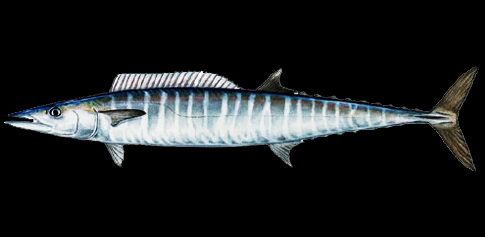
Anglers can use a double braided line attached to an 80-100lb leader about two feet long. A fast trolling rig will feature a 30-50 wide reel with wire leaders since the wahoo’s teeth can cut through mono or fluorocarbon easily. High-speed trolling at 12-15 knots with a 4-6 lure spread is commonly used to catch this fish. However, you may find the best place for Wahoo fishing is in their native Bahamas when they are migrating in high numbers between March and November. They are abundant in Florida from July to November and fishing Wahoo peaks in Hawaii from May to October. The angler will have success here especially during the cooler months. They can be found near oil and gas platforms, particularly near Port Aransas in Texas. In the Gulf of Mexico, the Wahoo doesn’t stray far from the shore. When cooked properly, wahoo can be an exceptional food item that satisfies even the most discerning palates. Wahoo is rich in omega 3's, niacin, vitamin B6, vitamin B12, and other nutrients. Wahoo is a healthy, extra-lean protein, low in saturated fat and sodium. This fish is well known for Wahoo fish tacos. Wahoo also has low oil content making it ideal for those who prefer less oily seafood. It's often compared to other pelagic fishes like tuna, swordfish, and mahi-mahi due to its delicate flavor. Wahoo has a firm texture with white meat that's mild and sweet tasting. The question that arises for most people is whether Wahoo Fish makes for a good meal or not. This species is known by names such as Ono in Hawaii and Peto or Beto in Mexico. Wahoo fish is a popular game fish found in the warm waters of the Atlantic, Indian, and Pacific Oceans. This large fish has a very diverse diet that consists of squid, tuna, little tunny, porcupine fish, flying fish, dolphinfish, jacks, herring, pilchards, scad, frigate mackerel, butterfish, and lantern fish, as well as many other pelagic species. It’s also coveted for its delicate flaky flesh, making it a premium-priced food fish.

Adults reproduce multiple times within the year-round spawning season, usually near Florida and the Caribbean. This increases the chances of fertilization and lessens the odds of the eggs being consumed. The Wahoo reproduces through broadcast spawning, where females release eggs simultaneously that males discharge sperm. Its lateral line stretches across its entire body and curves under the first dorsal fin.

The anal fin is aligned below the second dorsal fin and has 9 finlets. It has 2 dorsal fins that trail off into 8-9 finlets, leading to a forked caudal fin.
#Blue wahoo fish skin#
The wahoo has a fold of skin that covers its jaw when the mouth is closed which differentiates it from the Spanish mackerel and Atlantic mackerel. It has a beak-like snout, large mouth, and sharp serrated teeth. It has a shimmering blue back that may appear green from above and has silvery sides with zebra-like blue stripes or bars. The wahoo has a slender, elongated body covered with small scales. Wahoo (Acanthocybium Solandri) Fish Description


 0 kommentar(er)
0 kommentar(er)
